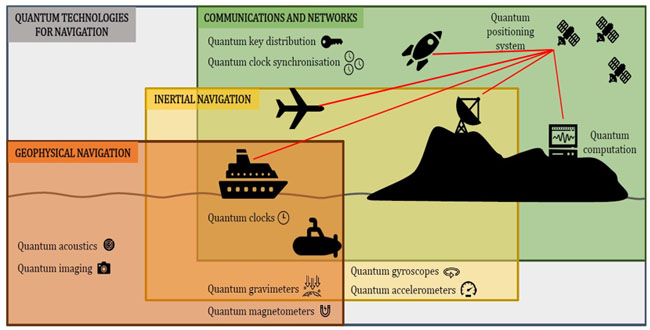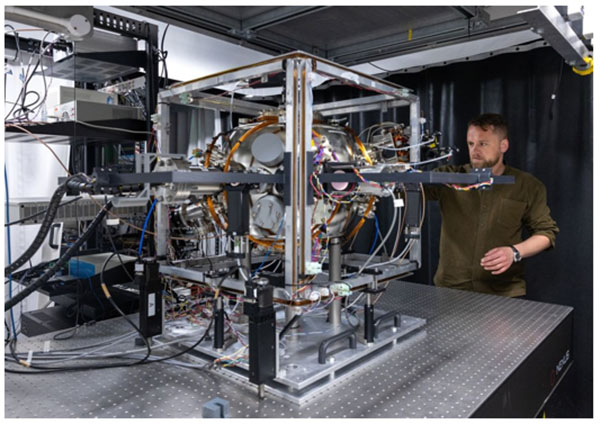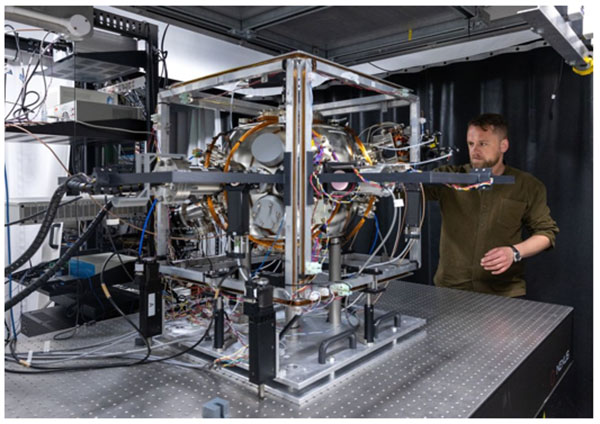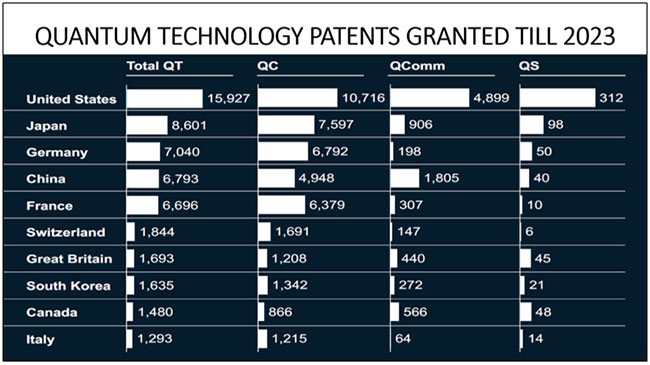Quantum Navigation for Military Applications
Summary
Accelerating research, development and commercialisation of quantum technologies will position India as a global leader and safeguard its national interests in the fast-evolving quantum landscape. Critical advancements in quantum sensing, navigation and communication are vital for defence, secure communications and national security.
Introduction
Quantum navigation technologies are poised to revolutionise military operations, particularly in scenarios where traditional navigation systems falter. As warfare becomes more dependent on stealth, autonomous systems and reliable navigation in GPS-denied environments, quantum technologies offer unparalleled precision, autonomy and security. In military contexts—whether on land, at sea, or in the air—these systems promise to overcome the limitations of Global Navigation Satellite Systems (GNSS) and Inertial Navigation Systems (INS). Quantum inertial sensors, gravimeters, magnetometers, positioning systems and quantum communication protocols can be employed to enhance military operations.
Limitations of GPS and Current Navigation Systems
GNSS, including GPS, has been the cornerstone of modern military navigation. However, the reliance on satellite signals makes these systems vulnerable to jamming, spoofing and physical attacks. GPS signals are easily disrupted by adversaries, and their reliability plummets in certain environments, such as underwater or in contested regions with dense signal interference. Modern conflicts, such as the ongoing Russia–Ukraine and Israel–Hamas wars, have exposed the inherent vulnerabilities of GPS, where signal jamming, spoofing and loss of service in contested environments severely impair military effectiveness. This limitation has forced military strategists and researchers to explore alternative navigation systems, with quantum technologies at the forefront as a potential game-changer. Furthermore, GNSS is unusable underwater, severely limiting its application for submarines or operations under Arctic conditions.
Quantum Inertial Navigation Systems (QINS): Revolutionising Dead Reckoning
Traditional inertial navigation systems, though capable of working independently of GNSS, suffer from ‘drift’—a cumulative error caused by imprecise accelerometers and gyroscopes. This error compounds over time, limiting the effectiveness of INS for long-duration missions without recalibration through GNSS. Quantum Inertial Navigation Systems (QINS), however, are based on atomic interferometry, which dramatically improves precision and minimises drift over time.1
Quantum accelerometers and gyroscopes use the principles of quantum mechanics, where super-cooled atoms (such as rubidium or caesium) act as highly sensitive motion detectors. For instance, the first quantum gyroscope using caesium atoms demonstrated a bias stability 300 times better than the best commercial-grade fiber-optic gyroscopes, and its angle random walk (a measure of noise) was 1000 times more accurate.2 This means QINS can provide highly accurate navigation for months without recalibration, making them ideal for military submarines or drones operating autonomously in GPS-denied environments.
Presently, quantum gyroscopes have reached an angular drift rate of 1e-6°/hr—significantly better than conventional systems that drift by 0.001° to 1°/hr leading to an error of 10 km/hr. This level of accuracy by quantum gyroscope reduces the navigation error typically associated with INS drift, allowing military assets to stay on course for extended periods without requiring surface fixes.
Quantum Positioning Systems (QPS): Autonomous and Tamper-Resistant
Quantum Positioning Systems (QPS) offer a game-changing alternative to GNSS. By utilising quantum accelerometers, gyroscopes and gravimeters, QPS can calculate precise positions without requiring external signals or satellite data, making it tamper-resistant and impervious to jamming or spoofing.
QPS relies on quantum-enhanced inertial sensors to continuously track a vehicle’s movement with pinpoint accuracy, even during long missions. When integrated with quantum gravimeters and magnetometers, these systems provide real-time position updates that are more accurate than any current satellite-based system. This is particularly useful for submarines, aircraft and drones operating in GPS-denied areas.
QPS technology can maintain positional accuracy within 1 cm, compared to the 1–5 m accuracy offered by GPS.3 This level of precision is crucial for stealth operations, such as missile deployment or reconnaissance, where even small deviations can compromise mission success.

Source: Olga Sambataro et al., “Current Trends and Advances in Quantum Navigation for Maritime Applications”, IEEE, August 2021.
Quantum Clocks: The Heart of Secure Military Synchronisation
Quantum clocks, such as optical clocks, represent the pinnacle of precision in timekeeping. These clocks operate with frequency uncertainties as low as 10^-18, far exceeding the performance of traditional atomic clocks. By providing ultra-precise time synchronisation, quantum clocks enable coordinated military operations, from missile launches to autonomous fleet management.
For instance, the JILA strontium optical lattice clock boasts a timing accuracy of 2.1 × 10^-18,4 allowing military networks to synchronize their operations without relying on satellite signals, which can be disrupted or hacked. In practice, this enables coordinated strikes across multiple platforms, ensuring timing precision within nanoseconds, a critical factor in modern warfare.
Quantum Key Distribution (QKD) for Secure Communication
In an era where cyberattacks and espionage pose significant threats, Quantum Key Distribution (QKD) offers an unbreakable encryption method for military communications. QKD leverages quantum entanglement to ensure that any attempt to intercept or tamper with communication immediately alerts the parties involved.
By using QKD, military units can securely share navigation data between command centres and autonomous vehicles without the risk of interception. This is especially valuable in GPS-denied environments where communication security is paramount. During covert operations, QKD can ensure that drones or submarines operating deep behind enemy lines receive secure navigation updates and pass data, minimising the risk of adversaries disrupting or spoofing them.
Table 1: Comparison of Anticipated Quantum and Conventional Maritime Navigation Technology Performance Capabilities
|
Technology |
Conventional Performance |
Quantum Performance |
|
Acoustics |
Resolution: 10 cm |
High resolution, low noise; Resolution: 1 mm |
|
Imaging |
Resolution: ≈ 1 cm@10m |
Sub-wavelength resolution; ultra low SNR; Resolution: <1 mm@10m |
|
Gravimeters |
Sensitivity: 1 cm/s², Drift: 0.01 µm/s²/hr |
High sensitivity, low drift; Sensitivity: 50 nm/s², Drift: <1 nm/s²/hr |
|
Magnetometers |
Sensitivity: ≈ 10⁻¹² T; Noise: pT/√Hz |
Ultra-high sensitivity <10⁻¹⁵ T; Very low noise <fT/√Hz |
|
Gyroscopes |
Accuracy: up to 0.01°/hr; Drift: up to 0.001°/hr |
High stability, low drift; Accuracy: <1e⁻⁶°/hr, Drift: <1e⁻⁶°/hr |
|
Accelerometers |
Precision: 10 nm/s², Noise: 100 nm/s² |
High precision, low noise; Precision: 1 nm/s², Noise: 10 nm/s² |
|
Quantum Key Distribution |
Susceptible to eavesdropping and cybersecurity attacks |
Unconditionally secure |
|
Clock Synchronization |
Frequency uncertainty: ≈ 10⁻¹⁸; Short term instability ≈ 1 × 10⁻¹⁶ |
Frequency uncertainty: <10⁻¹⁸; Short term instability <10⁻¹⁷ |
|
Positioning Systems |
GPS: 1-5 m accuracy |
Accuracy: 1 cm, global coverage |
|
Computation |
Baseline (1x speed) |
Accelerated: >1000x speedup |
(Source: Olga Sambataro et al., “Current Trends and Advances in Quantum Navigation for Maritime Applications”, IEEE, August 2021.)
Military Applications of Quantum Navigation Systems
Quantum navigation systems offer a range of applications across various military domains. From enhancing the accuracy of air and naval operations to improving the resilience of ground forces, QNS is poised to revolutionise modern warfare.
Maritime Operations
Quantum navigation technology has proven highly effective in maritime operations, as demonstrated by the UK Royal Navy’s test on the XV Patrick Blackett.5 This system allows accurate navigation without GPS, crucial for submarines that cannot use GPS underwater. Quantum-enhanced inertial navigation systems (INS) and quantum gravimeters enable stealthy, long-duration navigation for submarines, reducing detection risks. Additionally, autonomous underwater vehicles (AUVs) benefit from quantum systems by minimising drift, enhancing performance during extended missions.6

Airborne Operations
Boeing’s successful test of a quantum navigation system on aircraft is a key advancement, enabling precise GPS-free navigation, especially in GPS-denied environments.7 This is crucial for military aircraft like fighter jets, drones and transport planes, where GPS interference is common. Quantum navigation is also promising for drone warfare, ensuring effective operations despite GPS jamming.

Land-Based Operations
On land, quantum navigation enhances troop coordination and vehicle navigation in GPS-denied environments, in mountainous regions like Leh-Ladakh. Quantum systems embedded in soldiers’ gear or military vehicles including autonomous vehicles improve navigation, making them more resilient to GPS disruption and electronic warfare, especially for ISR (intelligence, surveillance and reconnaissance) in difficult terrain.8
Challenges and Future Prospects
Quantum navigation systems hold immense potential but face challenges such as sensor miniaturisation, making them difficult to integrate into small platforms like drones. Additionally, seamless integration with existing military tools like INS and GPS is needed for reliable hybrid systems. However, rapid advancements in quantum technology and materials science are addressing these issues. Successful trials by the UK Navy and Boeing suggest that quantum navigation systems could soon become standard in military applications.

Source: Isabelle Desouches, “Quantum Initiatives Worldwide 2024 – Qureca”, Qureca, April 2024.
India and Quantum Gap
Quantum technology is reshaping national defence, with a special focus on Quantum Communication (QComm) and Quantum Sensing (QS). China, the US, and countries of the European Union are investing heavily in this domain, aiming for breakthroughs in military applications. China, with a US$ 15.3 billion public investment, is leading globally, while India, despite its US$ 735 million National Quantum Mission launched in 2023, has a lot of catching up to do.9 The urgency for secure quantum communications intensified after the 2013 Snowden revelations, which exposed vulnerabilities to US cyber espionage. Consequently, President Xi Jinping prioritised quantum research in China’s 13th and 14th Five-Year Plans.10
A landmark achievement came in 2017 with the launch of Micius, the world’s first quantum satellite, which demonstrated secure QKD over 1,200 km and facilitated the first quantum-encrypted intercontinental video call between Beijing and Vienna. Additionally, Micius enabled the creation of a 2,000 km quantum communications trunk line between Beijing and Shanghai, achieving secure communication across 4,600 km. China is also developing mobile quantum ground stations and quantum-equipped drones, enhancing its secure communication infrastructure.11
In contrast, while India has made strides through initiatives like the National Mission on Quantum Technologies and Applications (NM-QTA), which allocates approximately US$ 1 billion over five years, it is still lagging behind. The Indian Institute of Science (IISc) has established a quantum technology research area, and ISRO demonstrated free-space quantum communication over 300 meters. However, China’s advancements in QKD and quantum sensing systems present a significant challenge to India’s technological leadership.12
The talent pool and patents further highlight India’s need to catch up. China has a talent pool of 91,000 graduates in quantum fields, compared to India’s 64,000. China has also been granted 6,793 patents in quantum technologies, while India’s share remains negligible. The USA leads globally with 15,927 patents and the EU follows closely behind (as shown in Figure 5), showcasing how far India needs to go in intellectual property development.13

Source: “Steady Progress in Approaching the Quantum Advantage”, McKinsey & Company, 24 April 2024..
Given these developments, India’s focus on post-quantum cryptography is insufficient. To ensure national security and maintain technological competitiveness, India must accelerate its quantum research and infrastructure development, particularly in quantum communications and sensing technologies, to counterbalance China’s growing influence in this critical area.
India’s development of quantum navigation systems is not just a technological ambition but a geopolitical necessity. As quantum technology increasingly shapes military and defence strategies, securing independence from foreign GPS systems becomes critical for maintaining national security, especially in times of geopolitical tension. China’s significant advancements in quantum communication and positioning systems highlight the risks India faces if it does not catch up quickly. The following roadmap outlines how India can strategically develop Quantum Navigation and Positioning Systems.
Build Quantum Research Infrastructure
To build quantum capabilities, India must continue expanding its quantum research and development (R&D) infrastructure. The National Quantum Mission (NQM) provides a solid foundation, but further investments are required to establish Quantum Sensing and Metrology Hubs at premier institutions like IITs and IISc. These hubs should focus on the development of quantum accelerometers, gyroscopes, gravimeters and Quantum key distribution (QKD), which are essential for the development of quantum navigation systems. Collaboration with international quantum research hubs will ensure knowledge exchange and access to advanced technologies, accelerating India’s quantum progress.
Strengthen Industry–Academia Partnerships
For quantum navigation systems to be developed rapidly, industry–academia partnerships are crucial. Companies like Tata Consultancy Services (TCS),14 Bosonqpsi15 and QNu Labs16 have already made contributions to quantum research, but greater collaboration with research institutions is needed. Encouraging partnerships between private enterprises and academia will drive innovation and lead to the faster development of quantum navigation prototypes.
Prioritise Quantum Sensing for Defence
India must declare quantum navigation a strategic priority for its defence sector. The Defence Research and Development Organisation (DRDO) and the Indian Space Research Organisation (ISRO) should focus on the development of quantum-based navigation systems for military applications, including quantum-enhanced inertial navigation for submarines, drones and missile systems. Additionally, quantum magnetometers and atomic clocks should be developed to provide precision for navigation in GPS-denied environments. QKD should also be prioritised to secure communications between military platforms and command centres.
Leverage Dual-Use Quantum Technologies
India should focus on dual-use applications of quantum sensing, serving both military and civilian needs. Technologies like secure satellite communication, autonomous transportation and disaster management systems can benefit from quantum sensing developments. Dual-use technologies will also accelerate commercialisation, enabling India to derive economic benefits from its defence investments.
Develop a Quantum-Skilled Workforce
For India to succeed in its quantum ambitions, there must be a concerted effort to build a quantum-skilled workforce. The NQM should include initiatives to train students and professionals in quantum physics, engineering and related fields. Encouraging public–private partnerships in workforce development and setting up dedicated quantum technology programmes at academic institutions will be critical for producing the next generation of quantum experts. This roadmap could set India on a path to quantum independence, crucial for securing national defence and staying competitive in the global quantum race.
Conclusion
India must rapidly develop its quantum technologies to remain competitive, particularly as China leads in areas like QKD and quantum sensing. While India’s efforts, such as ISRO’s quantum communication demonstrations and the National Mission on Quantum Technologies, show promise, the pace must be increased. Critical advancements in quantum sensing, navigation and communication are vital for defence, secure communications and national security.
Quantum sensing technologies, like high-sensitivity magnetometers and atomic clocks, are essential for precise navigation and cybersecurity, especially in GPS-denied environments. Similarly, quantum communication provides unbreakable encryption, crucial for safeguarding government and military networks. With China investing billions into its quantum infrastructure, India cannot afford to lag behind.
To ensure strategic and economic security, India must foster a robust quantum ecosystem, leveraging collaborations across government, academia and industry. Accelerating research, development and commercialisation of quantum technologies will position India as a global leader and safeguard its national interests in the fast-evolving quantum landscape.
Cdr Vikram Ravindran is an officer of Indian Navy, presently at Naval War College, Goa.
Views expressed are of the author and do not necessarily reflect the views of the Manohar Parrikar IDSA or of the Government of India.
- 1. Atomic interferometry in quantum technology exploits the wave-particle duality of atoms to make precise measurements. Atoms are cooled to near absolute zero and split into two wave-like paths using laser pulses. These paths are then recombined, creating an interference pattern that is highly sensitive to external forces like gravity, acceleration, or magnetic fields. By analysing the interference pattern, atomic interferometers can detect minute changes in these forces, enabling applications in quantum sensors, precision navigation and fundamental physics research, such as measuring gravitational waves and testing theories of quantum mechanics.
- 2. D. Durfee, Y. Shaham and M. Kasevich, “Long-term Stability of an Area-Reversible Atom-Interferometer Sagnac Gyroscope”, Physical Review Letters, Vol. 97, No. 24, 2006, p. 240801.
- 3. Olga Sambataro et al., “Current Trends and Advances in Quantum Navigation for Maritime Applications”, IEEE, August 2021.
- 4. T. L. Nicholson et al., “Systematic Evaluation of an Atomic Clock at 2 × 10(-18) Total Uncertainty”, Nature Communications, Vol. 6, April 2015, pp. 6896–6896.
- 5. “Royal Navy’s Quantum Navigation System”, Sky News, May 2024.
- 6. Olga Sambataro et al., “Current Trends and Advances in Quantum Navigation for Maritime Applications”, no. 3.
- 7. “Boeing Quantum Flight Test”, Financial Times, August 2024.
- 8. “Quantum Navigation for Autonomous Vehicles”, Defense Science Weekly, July 2024.
- 9. “National Quantum Mission”, Department of Science and Technology, Government of India.
- 10. “CSET Original Translation: China’s 14th Five-Year Plan”, Center for Security and Emerging Technology, 13 May 2021.
- 11. “Beijing-Shanghai Quantum Communication Network Put into Use-University of Science and Technology of China”, Ustc.edu.cn, 2017.
- 12. “ISRO Makes Breakthrough Demonstration of Free-Space Quantum Key Distribution (QKD) Over 300 m”, Indian Space Research Organisation, Department of Space, Government of India.
- 13. “Quantum Technology Monitor”, Report, McKinsey & Company, April 2023.
- 14. “TCS & IIT-Bombay to Build India’s First Quantum Diamond Microchip Imager”, Tata Consultancy Services, 28 May 2024.
- 15. See BosonQ Psi | Quantum-powered Cloud Simulations.
- 16. See “Armos–Quantum Key Distribution (QKD)”, QNU Labs.




